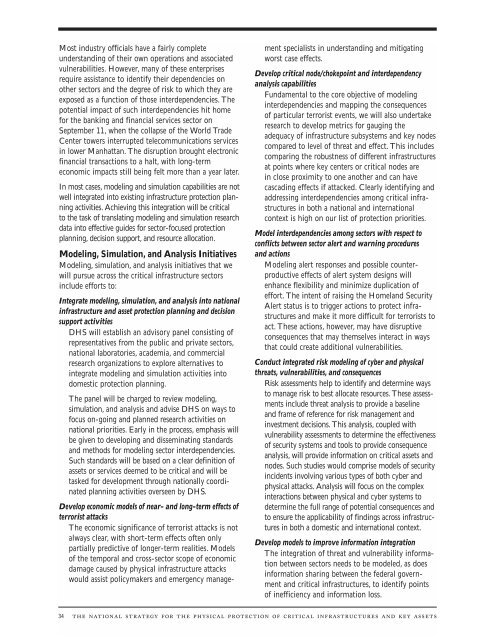the Physical Protection of Critical Infrastructures and Key Assets
the Physical Protection of Critical Infrastructures and Key Assets
the Physical Protection of Critical Infrastructures and Key Assets
Create successful ePaper yourself
Turn your PDF publications into a flip-book with our unique Google optimized e-Paper software.
Most industry <strong>of</strong>ficials have a fairly complete<br />
underst<strong>and</strong>ing <strong>of</strong> <strong>the</strong>ir own operations <strong>and</strong> associated<br />
vulnerabilities. However, many <strong>of</strong> <strong>the</strong>se enterprises<br />
require assistance to identify <strong>the</strong>ir dependencies on<br />
o<strong>the</strong>r sectors <strong>and</strong> <strong>the</strong> degree <strong>of</strong> risk to which <strong>the</strong>y are<br />
exposed as a function <strong>of</strong> those interdependencies. The<br />
potential impact <strong>of</strong> such interdependencies hit home<br />
for <strong>the</strong> banking <strong>and</strong> financial services sector on<br />
September 11, when <strong>the</strong> collapse <strong>of</strong> <strong>the</strong> World Trade<br />
Center towers interrupted telecommunications services<br />
in lower Manhattan. The disruption brought electronic<br />
financial transactions to a halt, with long-term<br />
economic impacts still being felt more than a year later.<br />
In most cases, modeling <strong>and</strong> simulation capabilities are not<br />
well integrated into existing infrastructure protection planning<br />
activities. Achieving this integration will be critical<br />
to <strong>the</strong> task <strong>of</strong> translating modeling <strong>and</strong> simulation research<br />
data into effective guides for sector-focused protection<br />
planning, decision support, <strong>and</strong> resource allocation.<br />
Modeling, Simulation, <strong>and</strong> Analysis Initiatives<br />
Modeling, simulation, <strong>and</strong> analysis initiatives that we<br />
will pursue across <strong>the</strong> critical infrastructure sectors<br />
include efforts to:<br />
Integrate modeling, simulation, <strong>and</strong> analysis into national<br />
infrastructure <strong>and</strong> asset protection planning <strong>and</strong> decision<br />
support activities<br />
DHS will establish an advisory panel consisting <strong>of</strong><br />
representatives from <strong>the</strong> public <strong>and</strong> private sectors,<br />
national laboratories, academia, <strong>and</strong> commercial<br />
research organizations to explore alternatives to<br />
integrate modeling <strong>and</strong> simulation activities into<br />
domestic protection planning.<br />
The panel will be charged to review modeling,<br />
simulation, <strong>and</strong> analysis <strong>and</strong> advise DHS on ways to<br />
focus on-going <strong>and</strong> planned research activities on<br />
national priorities. Early in <strong>the</strong> process, emphasis will<br />
be given to developing <strong>and</strong> disseminating st<strong>and</strong>ards<br />
<strong>and</strong> methods for modeling sector interdependencies.<br />
Such st<strong>and</strong>ards will be based on a clear definition <strong>of</strong><br />
assets or services deemed to be critical <strong>and</strong> will be<br />
tasked for development through nationally coordinated<br />
planning activities overseen by DHS.<br />
Develop economic models <strong>of</strong> near- <strong>and</strong> long-term effects <strong>of</strong><br />
terrorist attacks<br />
The economic significance <strong>of</strong> terrorist attacks is not<br />
always clear, with short-term effects <strong>of</strong>ten only<br />
partially predictive <strong>of</strong> longer-term realities. Models<br />
<strong>of</strong> <strong>the</strong> temporal <strong>and</strong> cross-sector scope <strong>of</strong> economic<br />
damage caused by physical infrastructure attacks<br />
would assist policymakers <strong>and</strong> emergency management<br />
specialists in underst<strong>and</strong>ing <strong>and</strong> mitigating<br />
worst case effects.<br />
Develop critical node/chokepoint <strong>and</strong> interdependency<br />
analysis capabilities<br />
Fundamental to <strong>the</strong> core objective <strong>of</strong> modeling<br />
interdependencies <strong>and</strong> mapping <strong>the</strong> consequences<br />
<strong>of</strong> particular terrorist events, we will also undertake<br />
research to develop metrics for gauging <strong>the</strong><br />
adequacy <strong>of</strong> infrastructure subsystems <strong>and</strong> key nodes<br />
compared to level <strong>of</strong> threat <strong>and</strong> effect. This includes<br />
comparing <strong>the</strong> robustness <strong>of</strong> different infrastructures<br />
at points where key centers or critical nodes are<br />
in close proximity to one ano<strong>the</strong>r <strong>and</strong> can have<br />
cascading effects if attacked. Clearly identifying <strong>and</strong><br />
addressing interdependencies among critical infrastructures<br />
in both a national <strong>and</strong> international<br />
context is high on our list <strong>of</strong> protection priorities.<br />
Model interdependencies among sectors with respect to<br />
conflicts between sector alert <strong>and</strong> warning procedures<br />
<strong>and</strong> actions<br />
Modeling alert responses <strong>and</strong> possible counterproductive<br />
effects <strong>of</strong> alert system designs will<br />
enhance flexibility <strong>and</strong> minimize duplication <strong>of</strong><br />
effort. The intent <strong>of</strong> raising <strong>the</strong> Homel<strong>and</strong> Security<br />
Alert status is to trigger actions to protect infrastructures<br />
<strong>and</strong> make it more difficult for terrorists to<br />
act. These actions, however, may have disruptive<br />
consequences that may <strong>the</strong>mselves interact in ways<br />
that could create additional vulnerabilities.<br />
Conduct integrated risk modeling <strong>of</strong> cyber <strong>and</strong> physical<br />
threats, vulnerabilities, <strong>and</strong> consequences<br />
Risk assessments help to identify <strong>and</strong> determine ways<br />
to manage risk to best allocate resources. These assessments<br />
include threat analysis to provide a baseline<br />
<strong>and</strong> frame <strong>of</strong> reference for risk management <strong>and</strong><br />
investment decisions. This analysis, coupled with<br />
vulnerability assessments to determine <strong>the</strong> effectiveness<br />
<strong>of</strong> security systems <strong>and</strong> tools to provide consequence<br />
analysis, will provide information on critical assets <strong>and</strong><br />
nodes. Such studies would comprise models <strong>of</strong> security<br />
incidents involving various types <strong>of</strong> both cyber <strong>and</strong><br />
physical attacks. Analysis will focus on <strong>the</strong> complex<br />
interactions between physical <strong>and</strong> cyber systems to<br />
determine <strong>the</strong> full range <strong>of</strong> potential consequences <strong>and</strong><br />
to ensure <strong>the</strong> applicability <strong>of</strong> findings across infrastructures<br />
in both a domestic <strong>and</strong> international context.<br />
Develop models to improve information integration<br />
The integration <strong>of</strong> threat <strong>and</strong> vulnerability information<br />
between sectors needs to be modeled, as does<br />
information sharing between <strong>the</strong> federal government<br />
<strong>and</strong> critical infrastructures, to identify points<br />
<strong>of</strong> inefficiency <strong>and</strong> information loss.<br />
34 THE NATIONAL STRATEGY FOR THE PHYSICAL PROTECTION OF CRITICAL INFRASTRUCTURES AND KEY ASSETS

















